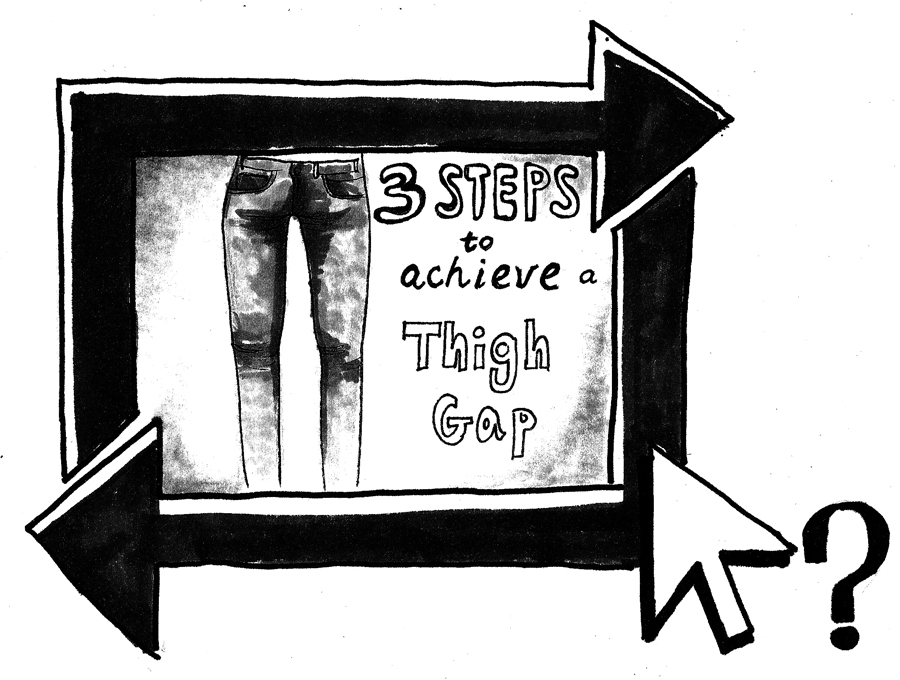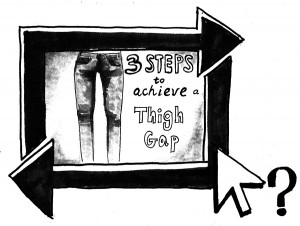‘Thigh gap’ sets harmful body image standards
This might be a slightly contentious thing to say, but my favorite social media platform is Tumblr. Unlike Facebook, Twitter or Instagram, my real name and personal life does not necessarily need to be attached to Tumblr. In this digital age where everyone is so easily identified online, it’s nice to hold on to some anonymity, a commodity seldom found. Of course, adopting a persona over the Internet calls for healthy online etiquette, which I strive to practice.
My “board” is filled with whatever gives me inspiration, including fashion, quotes, celebrities and, of course, cats. Something I have been inclined to repost in the past is the infamous “thigh gap,” a term to describe the space between one’s thighs when standing upright with both feet touching.
Everyone has insecurities. There are some things about my body that are not perfect, so Tumblr is a good avenue to give people ideas for a healthier lifestyle. The thigh gap phenomenon, however, took this inspiration to extremes, making me feel extremely vulnerable. When I looked at the space between my thighs and the space between the thighs in the Tumblr post for the first time, I decided which look was definitely more desirable. There was something about Internet affirmation that made the portrayal of that particular body image so much more worthy. This trend even came up in conversations I had with my friends. We had all heard of the thigh gap online or in passing, or have always known about it in the back of our minds. Though we agreed that we would never go to extraordinary lengths to achieve said thigh gap, we all thought society put this trend on a pedestal. Moreover, we thought it was something people unnecessarily obsessed over.
Turns out, obsession is a fitting word. Many users on the Internet communities often post about “thinspired,” and the thigh gap is just a component of the thinspiration train. According to Time, many Tumblr users felt threatened by the “ideal” body posts and were changing their own images that Tumblr had to take precautions to stop the self-harm from circulating further. Scientifically speaking, however, thigh gaps aren’t attainable for everyone. According to the website Fitness Blender, that space is dependent on bone structure, which is impossible to control.
But even knowing this proven fact does not deter me from having thoughts to change my body. I feel as if social media’s stamp-of-approval is the end all, be all of standards. And though my insecurities are not extreme, I wonder how many people out there are starving themselves or bulking up to achieve the body they deem perfect. I wonder how many people were meticulously counting their calories and obsessing over their intake. I wondered if there were options online that showed them a realistic view of body sizes.
Instead of logging onto Tumblr to scroll through my feed, today I went online with the sole intent of looking for body-positive blogs. I found plenty heralding the dimensionality of bodies and celebrities like Lena Dunham, Jonah Hill and Mindy Kaling relaying to their fans what the true meaning of the ideal image is. We need more messages like these in the social media spotlight.
The power that the web holds over people is disheartening, and unfortunately enough to dictate what they should or should not look like, when it’s often uncontrollable. When opinions online come in anonymous hordes, it is hard not to give in to these ideals. There are, as I have found, places on the Internet that celebrate everyone for their natural form. That community should be the one inspiring people everywhere, not the one that points out the inches between the upper thighs.
So, my Tumblr now will have a new message … still with cats, of course.
Danni Wang is a freshman majoring in psychology. Her column, “Pop Fiction,” runs Tuesdays.



Hi Danni, I just wrote a blog post on my history with the “thigh-gap”. I appreciate reading your thoughts and share many of them. Thanks for your honesty.
Natalie